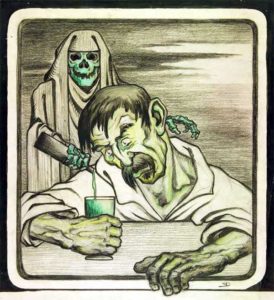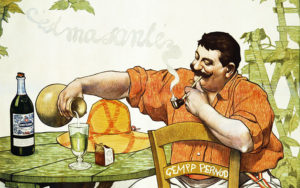As probably most of you know, Absinthe, the Green Fairy, got banned by the beginning of the 20th century. In the following article, we have put together some information about Absinthe prohibition. There are so many rumors out there about Absinthe and its prohibition, therefore it is good advice to check out these facts.
Countries that officially prohibited Absinthe
Even though there had been a few places that had banned Absinthe already, one can say that the whole prohibition movement started around 1905 in Switzerland. Absinthe was increasingly blamed to be poisonous and got the scapegoat for all social issues relating to alcohol consumption. The decision to officially ban the Green Fairy was made in 1908 and in 1910 the ban was implemented in the Swiss constitution. In the Netherlands (1909), United States (1912) and France (1914) Absinthe got as well prohibited. Germany followed in 1923.
Absinthe prohibition, why?
By the turn of the century, the Green Fairy had been increasingly perceived as a spirit that makes people insane and very violent. In 1905, it was reported that a Swiss farmer murdered his family after drinking Absinthe (read more about the Jean Lanfray murder in our separate blog post). That was when the negative discussion about the Green Fairy rose to a new level. The green spirit was blamed as being the reason why Mr. Lanfray killed his family. But there is something that had not been taken into consideration: The farmer had drank a lot of wine and brandy prior to drinking two glasses of Absinthe. So did the two glasses of Absinthe really made the difference…? We have our doubts.

Absinthe prohibition: The real reason of the ban
The real reason why Absinthe got banned has to do with the wine industry’s business interests. Up until the late 19th century, wine and wine-based products like Cognac were the preferred drink in society. But this changed in the mid-19th century, when grape phylloxera hit the French vineyards. As most wine was destroyed, wine and Cognac prices skyrocketed. As a matter of fact, people were in search for a substitute and Absinthe was the answer: A high-proof alcoholic drink made with wormwood. It helped, that the drink was already popular among artists and the military. The French Army had handed out rations of Absinthe to its African troops to cure stomach diseases, and soldiers started to love the drink. The price for a bottle of Absinthe was reasonable as well. Especially if you think of its alcoholic strength (real Absinthe has 138 proof). So it didn’t take long, and Absinthe was the new drink of choice for many people.
Absinthe gets banned
It didn’t take long and the winemakers had to realize that people who used to be their customers, were now drinking Absinthe. The only logical solution for them was stigmatizing the new competitor! And so they did… The Jean Lanfray murder was a perfect incident, to blame the Green Fairy. Also, the fact, that a lot of the artists who were drinking Absinthe were known to have psychological disorders, helped to spread the myth, that the Green Fairy makes you mad. Last but not least, the research of a French psychiatrist (Dr. Valentin Magnan) helped. He gave the “scientific” proof that Absinthe was poisonous.
Dr. Magnan experimented with rats and injected wormwood oil into their bodies. And guess what, the little animals eventually died. The problem with his research was the fact that he used pure wormwood oil instead of Absinthe and his experiments were (of course) never peer reviewed or verified. Why? Because Dr. Magnan was convinced that alcohol (especially Absinthe) was harming social order. He eagerly wanted to see it banned…
In the end, the wine industry used massive political influence to ban Absinthe. They finally reached their goal with the prohibition of Absinthe throughout Europe between 1909 and 1914 (USA 1912). Without the Green Fairy competing with their products, wine and Cognac dominated the market once again.
Is Absinthe, aka the Green Fairy, toxic?
There has always been whether Absinthe is toxic or not. This question arose due to the fact that wormwood, one of its most important ingredients, contains thujone, which indeed can be toxic. Nevertheless, it only is toxic in very high doses. Absinthe, just like so many other products that we eat regularly, does not contain enough thujone for us to worry. And no, Absinthe brands of the past neither contained high levels of thujone. Vintage Absinthes were analyzed and guess what, the levels of thujone were often under the levels that are legal today (35mg/liter).
Post-prohibition: The revival of the Green Fairy
It took some time until Absinthe got legalized once again. A British importer realized in the 1990s that Absinthe never formally had been banned in the UK. That is when the Czech brand Hill’s Absinthe was imported into the UK (the Czech Republic neither had banned Absinthe, therefore you could legally buy it there). Starting from Prague and London the Green Fairy gained some awareness in the bar and nightclub scene. That’s what kicked the revival off and Absinthe distillation and distribution started in various other countries as the Green Fairy was in fact re-legalized: As the drink was legal in some countries, the EU harmonized laws and the drink was finally permitted in all EU countries by the beginning of the 21st century!
In early 2000 Hollywood got aware of the Green Fairy as well. Fascinated by the drink’s rich history and inspired by the recent hype, they started to make famous movies that further helped to spread the word of the Green Fairy. Moulin Rouge, From Hell, Dracula are just a few to name where Absinthe was served. The Green Fairy was officially back!
Finally, what is the effect of Absinthe?
Sorry, you will not see pink elephants after drinking some glasses of Absinthe. But you can experience a mental awareness. It is a result of the high level of alcohol (68-90% alc. by vol) and the essential oils of the distilled herbs. The effect is different to what you are used to when drinking alcohol. You can read more about the Absinthe Effect in this article. And please, do not burn Absinthe, although they serve it like this in many bars and as well in the movie Moulin Rouge. You can read more about how to drink Absinthe the original way in our separate article.
We do hope that you enjoyed this blog post about “Absinthe prohibition”. You want to tell us something? Just leave a comment, or visit us on Facebook or Instagram.
Much Love.
Nico from the ALANDIA Team




Thank you! I have been intrigued about this for a long time. My interest is in the cup and slotted spoon which holds the sugar cube. I collect unusual things and would love to have this. Any suggestions?
Would like to have the cup and slotted spoon which holds the sugar cube.
Any suggestion?
Yes, the Feuilles spoon is one of the nicest and true to the original: https://www.alandia.de/absinthe-spoon-feuilles.html
Cup and slotted spoon, where to purchase these? Annie
Thank you for this informative article! Is it still banned in the United States? I have been dying to taste it!
Dear Deborah, you can buy the glasses and spoons at our Absinthe store: https://www.alandia.de/accessories
Dear Rose, no Absinthe is not banned any longer in the USA, read more about it here: https://www.alandia.de/absinthe-legal